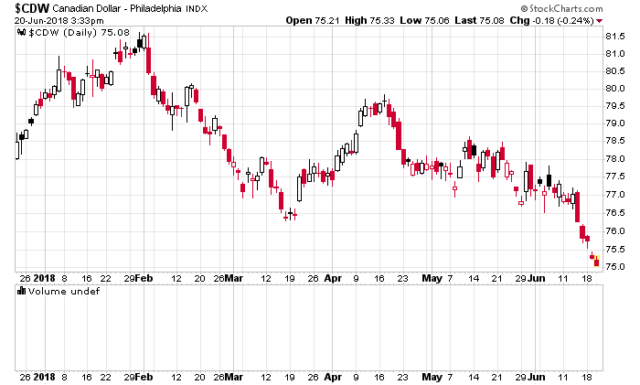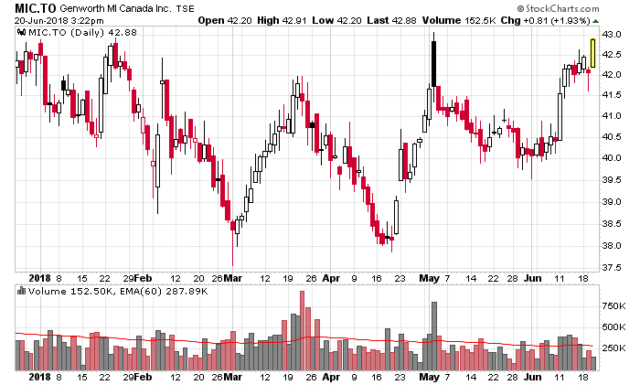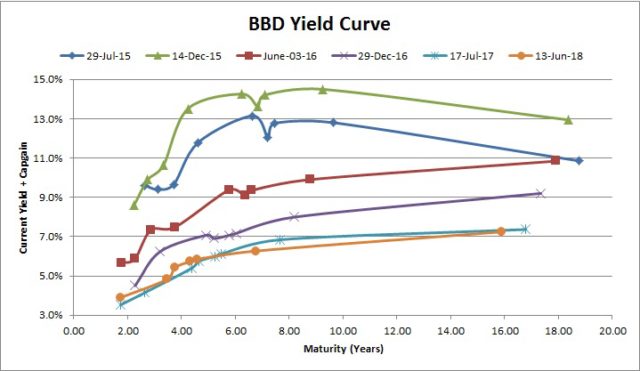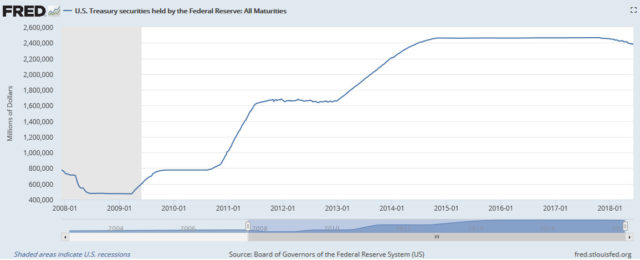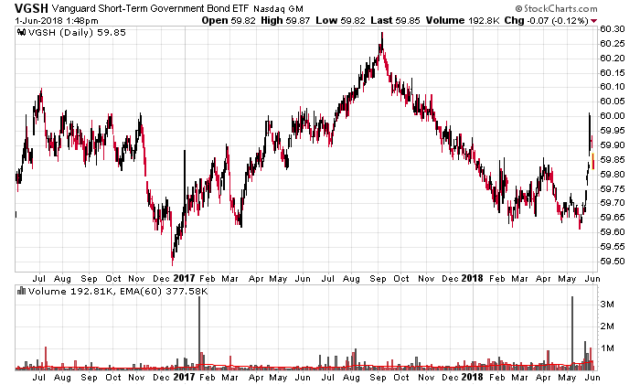Canadian Dollar, Genworth MI and Residential REITs
This will be a rambling post in no particular order.
1. The Canadian dollar has tumbled with Donald Trump beating the war drums on the trade portfolio:
This will keep going lower and lower until the Government of Canada realizes that a lower currency doesn’t mean you’re more competitive when you’ve basically killed your own industry. Normally there is correlation between oil prices and the Canadian dollar but this linkage has now been considerably more muted because of WTIC to Alberta oil differentials. Investment has been flowing away from Alberta/SK oil and everything is on maintenance mode.
This will clear the way, however, for the Bank of Canada to raise interest rates another quarter point.
Domestically, this is going to be a disaster for general Canadian standards of living. It seems to be that our largest urban export is continuing to be real estate.
2. Speaking of real estate, bearish market participants in Genworth MI are going to face a short squeeze:
I’m not sure why anybody would want to use Genworth MI as a proxy for Canadian housing when there are so many more other investment vehicles to express this sentiment, ones that are trading well above book value and are making nowhere close to as much money as Genworth MI is on their insurance portfolio.
I’ll send a “hat tip” to Tyler, who writes infrequently at Canadian Value Stocks, for the brief mention of my continuing analysis of Genworth MI. The best analogy I can give is “picking up hundred dollar bills in front of a steamroller” instead of the usual cliche of “picking up nickels”. Genworth MI is claimed to be poised to have a giant collapse, but the variables required to make that happen seem distant at this point in time. Hint: Pay attention to China.
3. Speaking of real estate, the most hyped investment seems to be mortgage REITs and also residential REITs. The cap rates received by purchasers are incredibly low. Example press release linked here, key quotation in the first paragraph:
Northview Apartment Real Estate Investment Trust (“Northview”) (TSX:NVU.UN) today announced that it has agreed to acquire a 623 unit portfolio of six apartment properties (the “Acquisition Properties” or the “Acquisition”) from affiliates of Starlight Group Property Holdings Inc. (“Starlight”). The aggregate purchase price of the Acquisition Properties is $151.8 million (excluding closing costs), representing a weighted average capitalization rate of 4.5%.
A 4.5% cap rate? Do I even need to open a spreadsheet to know that the purchasing side of the transaction is wholly reliant on capital appreciation of the underlying properties for this to make financial sense?
The big favourite in this market is Canadian Apartment Properties (TSX: CAR.UN) and they probably can’t even believe how much their equity has traded up over the past year. They did a secondary at $35.15/unit and probably feel like idiots since just three months later they’re trading at $43/unit.
We drill down into their financials and see that from the last quarter, extended to 12 months, their normalized funds flow through operations (recall that accounting rules will add gross amounts of volatility in REITs due to mark-to-market rules when properties are re-appraised and this difference will be added or subtracted from income, making standard income statement comparisons incomprehensible without going through mental gymnastics) results in a net yield of about 4.3%.
An investment in CAR, therefore will expect to receive 4.3% plus the variable components of changes of rental amounts, property values, financing and operating expenses, and vacancy rates. Will these variable components be enough to give a rational equity investor a higher rate of return as surely nobody would want to take equity risk for a measly 4.3% gain?
Bombardier Yield Curve
It has been awhile since I’ve posted the progression of the Bombardier debt yield curve, but clearly things have stabilized at the investment grade quality level:
The corporation itself has also raised half a billion (US$) in an equity offering, and has warrants outstanding to purchase shares of its class B stock which are now well within the money. This will be another CAD$500 million that will go to their treasury when it is exercised. Solvency-wise, the company looks like it is once again on stable footing now that the liabilities associated with the C-Series jet has been dumped off to Airbus.
I will likely discontinue my Divestor coverage of Bombardier after this post. The story is over. A few years ago, people were selling down their preferred shares to ridiculously high yields (22%) on the premise that they were not going to be able to stay solvent while they financed their C-Series jet. This was a classic time to capitalize on the cascade of emotional negative sentiment towards the corporation. I even got a media mention for this.
I’m still holding onto my Bombardier preferred shares, although strictly from a valuation perspective, I would not be buying them at the existing price. However, due to the unrealized capital gain and the fact that I have nothing else better to invest my cash with, I will be holding my holdings indefinitely.
US Federal Reserve tightens the noose
The US Federal Reserve, much to nobody’s surprise, raised interest rates another 0.25% for a target rate of 1.75-2.00%.
In the implementation note, they also stated the interest to be paid on bank reserves would be 1.95%, which is a departure from the usual top of the range (2%) by 5 basis points. This will probably pin the effective short-term rate at 1.95% instead of at 2%.
The other news, which is equally not surprising, is an increase in the repurchase amounts of treasury and mortgage-backed securities held by the reserve:
The Committee directs the Desk to continue rolling over at auction the amount of principal payments from the Federal Reserve’s holdings of Treasury securities maturing during June that exceeds $18 billion, and to continue reinvesting in agency mortgage-backed securities the amount of principal payments from the Federal Reserve’s holdings of agency debt and agency mortgage-backed securities received during June that exceeds $12 billion. Effective in July, the Committee directs the Desk to roll over at auction the amount of principal payments from the Federal Reserve’s holdings of Treasury securities maturing during each calendar month that exceeds $24 billion, and to reinvest in agency mortgage-backed securities the amount of principal payments from the Federal Reserve’s holdings of agency debt and agency mortgage-backed securities received during each calendar month that exceeds $16 billion. Small deviations from these amounts for operational reasons are acceptable.
This quota (currently $18 billion in treasuries and $12 billion in mortgage-backed securities per month) has been continually rising every quarter. Now this will be $24 billion and $16 billion per month, respectively.
As you can see by very far right-hand side within the chart above, the amounts involved are still a drop in the bucket – between July and September will be another USD$120 billion removed. But the slope of the curve, every quarter, will continue to get steeper and steeper.
Although short-term interest rates are still exceptionally low from a historical perspective, without a doubt the monetary situation is going to create an increasing headwind. This is akin to running on the treadmill and adjusting the elevation from flat to a 1% incline – while the running is still relatively easy, it takes a bit more energy to achieve the same distance. For each increment that the Federal Reserve raises rates, the incline gets higher and higher and eventually you’ll have to stop and catch your breath.
That’s probably the ideal time to invest again. Until then, safety and capital preservation is the name of the game.
Finally, my other comment is that I would view it as more probable than not that the Bank of Canada will match the Federal Reserve’s rate increase on their July 11th meeting.
Safe cash parking in USD
I’ve spoken about US dollar cash parking in the past (back in 2011!). Since then the offerings have not changed tremendously – the standard option is VGSH which gives you 2-year duration exposure to US interest rates. Whenever interest rate hikes abate, this ETF should do reasonably well – unless if there is a massive inflationary spike.
Interactive Brokers gives out 1.2% on US cash balances. This is not a terrible option if you don’t want to engage in transactions to eek out another 80 basis points or so of “nearly risk-free” money. However, other brokers generally don’t give out interest income on their idle cash balances and thus it makes it worthwhile to shop for short-term options if you have high cash balances while you wait for better investment options (as you can tell, I’m in that situation currently).
VGSH has been a perennial standby, but the duration risk over the past couple years really shows itself in the charts:
Interestingly over the past two weeks the 2-year US treasury dropped in yield from about 2.58% to 2.32% and hence this was enough to take the ETF up about 0.6% which is very unusual volatility historically. VGSH right now has a YTM of 2.5% and an MER of 0.07%, which still makes it very cheap for short-term exposure to 2-year AA-rated debt.
Still, one annoyance is that if you were unlucky to hit the rising interest rate lottery and be one of those September 2017 investors in VGSH, it can be annoying especially when you know you’re still in a tightening interest rate environment. Since 2011, there is an alternative ETF class that seems to offer a solution: target-date maturity ETFs.
In particular, BSCI will terminate at the end of December and contains investment-grade corporate ETFs that will mature throughout 2018. After June, the ETF will accumulate cash (by maturities) and invest the proceeds in T-Bills until the final termination at the end of the year. The yield to maturity on this fund is 2.17% and MER is 0.1%, so this is not a bad way to skim a couple percentage points while waiting. The ETF is also exceptionally liquid (spreads are a penny wide in size).
The main competitor to this is IBDH, and it is slated to mature on December 15, 2018. It is mostly the same product as BSCI except that it is already in its cash accumulation phase (47.5% in a short-term treasury fund). This will give 2.1% minus 0.1% in MERs. Liquidity is also typically a penny on the exchanges.
Barring a massive financial crash of cataclysmic proportions (e.g. something bigger than 9/11 – I’m thinking around the scale of multiple nuclear detonations in major US cities where we would have bigger problems than how to liquidate our investments from the radioactive ashes), these ETFs are modestly safer than VGSH by virtue of their lower duration. They seem to be a good vehicle to park cash in a rising interest rate environment.
